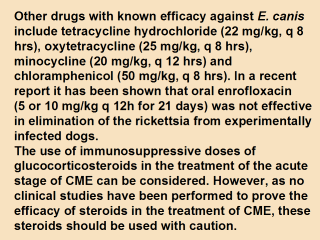| front |1 |2 |3 |4 |5 |6 |7 |8 |9 |10 |11 |12 |13 |14 |15 |16 |17 |18 |19 |20 |21 |review |
 |
When demonstrating other Rhipicephalus-borne parasites such as Hepatozoon canis or Babesia canis, in blood smears, coinfection with E. canis should always be considered, as this is sometimes common. Coinfections with E. platys, which is presumed to be transmitted by Rhipicephalus sanguineus, the brown dog tick are also common. Concurrent infections of E. canis and Borrelia burgdorferi or Leishmania donovani have been documented, indicating the strong possibility of coinfections with other parasites, that are not transmitted by ticks. Standard inseticide-impregnated dog collars efficiently protect against ALL insect-borne parasites. |